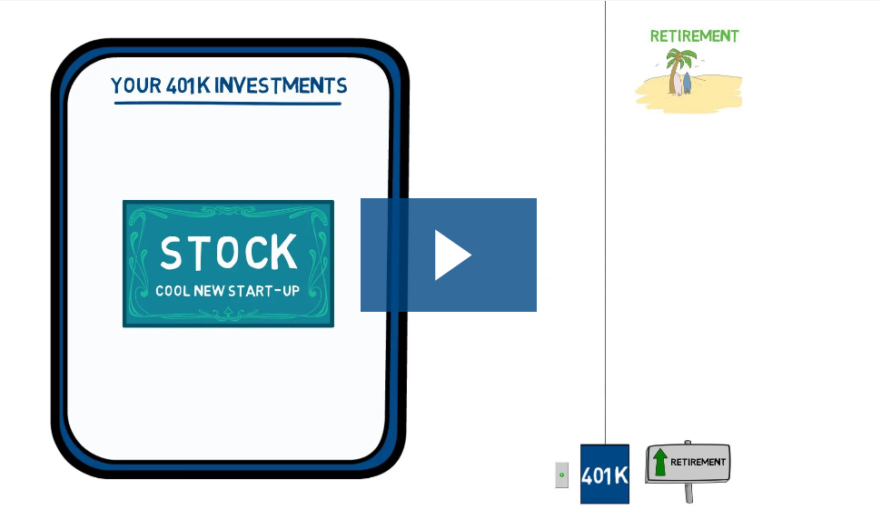As far back as our childhood, we have been told that we should never put all our eggs in one basket. If the basket breaks, so will all the eggs. This is the basis of one of the important principles of investing: Reduce your risk through diversification.
For a more vivid illustration of how diversification reduces risk, imagine you’re trying to get to the top floor of a really tall building and the only way up is to take one of two elevators. The one on your left is supported by a single skinny cable. The one on your right is supported by 10 cables. Which do you choose? The one with 10 cables, naturally!
Diversification: Crash-proofing your retirement portfolio
Now imagine that your 401(k) plan is your elevator up to retirement. If you have only one stock in your portfolio, your portfolio will bounce up and down as that stock’s price varies. If that company goes bankrupt, your retirement portfolio will come crashing down.
You could add a few more stocks, but would you get on an elevator with just a few cables?
You could also add some bonds, which would help because they can act as a counterweight when stocks are performing well.
You could stabilize your portfolio even more by adding a few stocks and bonds from outside the US. That’s because global markets tend to perform differently than the US stock market.
While these additions to your portfolio can help to smooth out the bumps, your portfolio still wouldn’t be fully diversified because all your investments are still linked to the markets. To continue our analogy, the cables lifting your 401(k) still isn’t nearly strong enough to prevent a possible disaster.
So what exactly is diversification and how does it work?
It’s very difficult to know which market sector or asset will outperform another, as different sectors and asset classes perform differently. Instead of trying to guess, diversification allows you to capture the returns wherever and whenever they might occur while keeping the overall volatility of your portfolio low. When it’s done properly, a diversified portfolio should outperform a more concentrated portfolio over the long term.
The key is to choose non-correlating assets to mix into your portfolio. For example, stocks and bonds are non-correlating assets: When stocks are performing well, bonds tend to underperform. But at least bonds continue to generate a yield when their prices underperform. When stock prices decline, bond prices tend to rise, so they provide a counterweight to declining stock prices. Real estate is also a good hedge against declining stock prices.
The key to building wealth is not through seeking big gains in your portfolio; rather it is to minimize your losses during market declines, which is the purpose of diversification. In the past, if you wanted to construct a properly diversified portfolio of stocks and bonds, you would need a large amount of money ($1 million+). That’s because you would need to purchase a basket of individual stocks and bonds large enough to achieve broad diversification. But today, mutual funds let investors invest any amount of money in a basket of securities.
Mutual funds offer instant diversification
Mutual funds are designed to give investors instant diversification in any asset or market sector at a low cost. A typical mutual fund invests in dozens of securities targeting a specific investment objective, such as conservative growth, aggressive growth, income, and capital preservation. Through mutual funds, it’s possible to own hundreds of securities with an investment of as little as $10,000.
But before you rush to load up on mutual funds for the sake of diversification, you need to understand what drives their performance. There are thousands of mutual funds to choose from and simply picking the best performing funds doesn’t guarantee good future performance. The market has a lot to say about which funds will perform better than others.
What exactly is “the market” and how does it work? We’ll answer those questions in a future blog post.
If you’d like to learn more about diversifying your investment portfolio, click the button below to schedule a free consultation with one of our investment advisors.
14,900+
Students
120+
Reviews
$99.95 $10
Cost
Should you enroll in your 401k plan? How much should you save? Which investments should you choose? Getting these answers wrong could cost you 100,000's of dollars! Check out our course that will help you come up with a simple plan to reach retirement using your 401k plan.
Get 90% Off Course








Comments 2
This blog is really very informative because you’ve explained each and everything which is amazing.
Both mutual funds and ETFs offer really good diversification options with a reasonable expense ratio and with no headache of research. For a newbie investor mutual funds and ETFs are great but if you can research a little bit then taking positions in stocks directly can be more profitable.